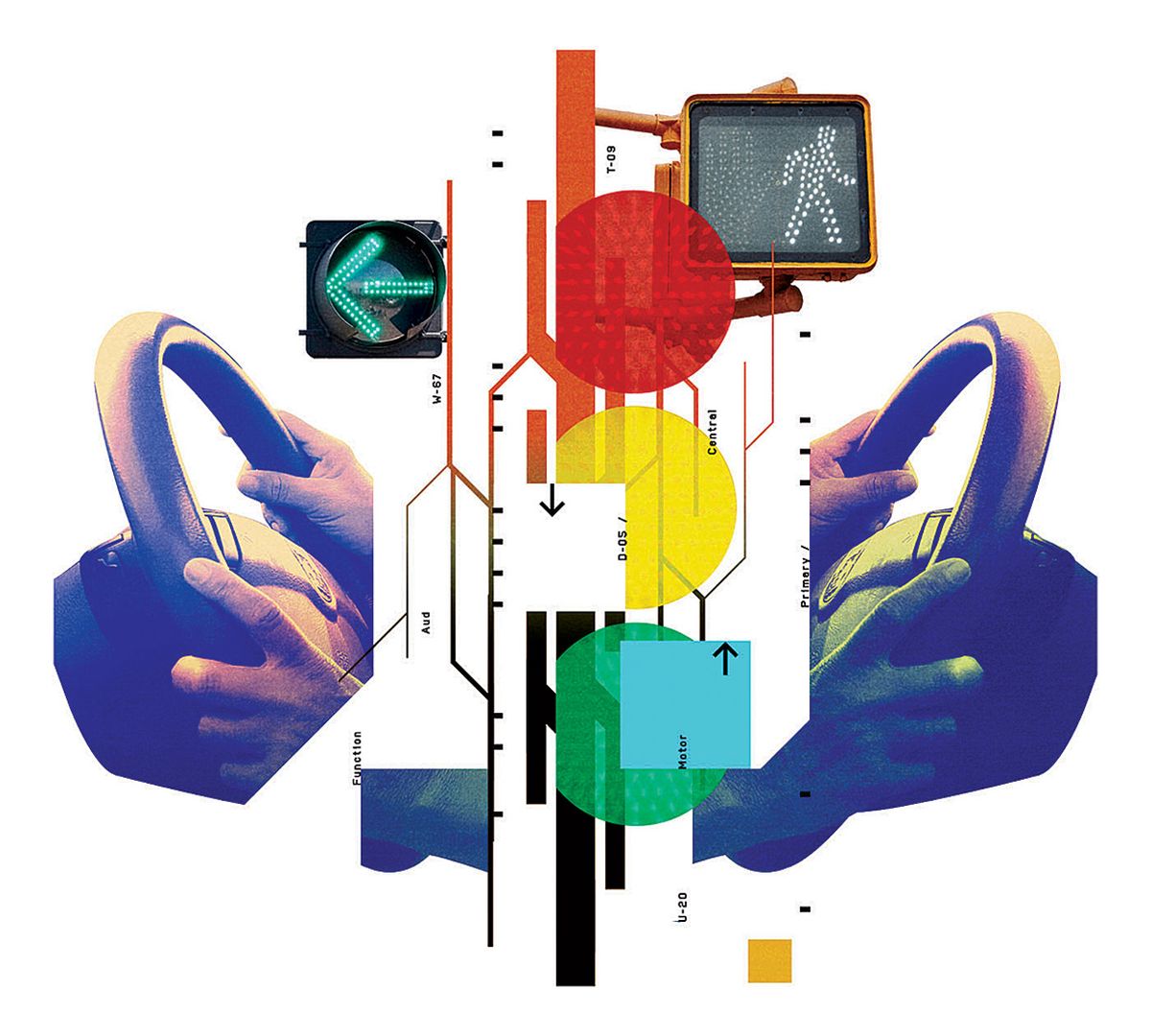Drivers can use a number of signals to communicate with other drivers: taillights, high beams, the horn. But car manufacturers envision a future where cars themselves will exchange messages about where they’re going and where they’ve been.
Connected vehicles—those fitted with technology that allows them to communicate with other drivers, pedestrians, and nearby infrastructure—are increasingly being tested around the world. In July, Columbus, Ohio, will be the latest city to launch a connected-vehicle pilot.
Connected vehicles have long been overshadowed by their more famous cousins: autonomous vehicles. Although all autonomous vehicles have aspects of connectivity, adding certain technologies to ordinary cars could prevent accidents and save lives in the near term.
The Connected Vehicle Environment project in Columbus will see up to 1,800 public and private vehicles fitted with special onboard units and dashboard-mounted head-up displays. Those cars will be able to receive messages from traffic lights at 113 intersections, including some of the city’s most dangerous crossings. The aim is to study the impacts of connectivity on safety and traffic flow. Organizers will begin recruiting drivers and installing onboard units in July, with testing to begin in November.
The technology will enable “basic safety messaging,” including warnings to reduce speed or look out for pedestrians ahead, explains Luke Stedke, who manages communications at Drive Ohio, the state’s smart-mobility center. The pilot is part of the Smart Columbus initiative, which was launched after the city won US $40 million in the U.S. Department of Transportation (DOT)’s 2015 Smart City Challenge.
Columbus joins two other cities in Ohio—Marysville and Dublin—that have recently begun testing connected vehicles. Collectively, the DOT has invested more than $45 million in such trials in Wyoming, Tampa, and New York City.
The keen interest in connecting nonautonomous vehicles comes primarily from the technology’s potential to reduce crashes and save lives, says Debra Bezzina of the University of Michigan’s Transportation Research Institute. Sensors to alert drivers to hazards in their blind spots, streetlight-mounted cameras that show a pedestrian at an upcoming intersection, and an approaching car that warns of black ice ahead are just a few examples of what may be possible.
“Connected-vehicle technology can prevent 80 percent of all unimpaired car crashes,” says Bezzina. “So it could save billions of dollars a year.”
The new technology also promises more efficient traffic management and greener commuting. Emergency vehicles could move through intersections quicker with all the lights in their favor. Motorists, using information broadcast by traffic signals about their phase and timing, could adjust their speed accordingly and save fuel.
Connected-vehicle communications can run either on a wireless technology called Dedicated Short-Range Communications (DSRC) or on a cellular-based alternative called Cellular-V2X. DSRC is scalable, offers low latency, and works well in an urban environment, says mechanical engineer Joshua Siegel from Michigan State University (MSU). But it has a limited range (roughly 1 kilometer).
C-V2X, on the other hand, has higher latency but superior range and greater bandwidth. With experts predicting that the rollout of 5G will improve latency, some countries, including China, have favored cellular networks. But the United States hasn’t given a clear edict on the issue, causing much uncertainty for automobile manufacturers.
Similar to other pilots around the country, the new Columbus trial will employ DSRC technology, which is farther up the road to being commercially available than C-V2X modules.
Many car manufacturers are keen to incorporate communications technology because it offers benefits that self-driving vehicles can’t. For one, the tech works in all weather conditions, unlike notoriously fickle radar and lidar detection systems.
Another advantage: “You can get information from infrastructure that you just cannot get with an autonomous vehicle,” says Bezzina. While autonomous-vehicle sensors might be able to inform you of a red light ahead, she says, connected-vehicle technology is capable of telling you that “there’s a light ahead, it’s located here, here’s what the geography of the intersection looks like, and that light will only remain red for the next two seconds. It’s much deeper information.”
The next step for connected-vehicle trials would be to expand testing from 1,000 vehicles to possibly 1 million, says MSU’s Siegel. “We’re not seeing the full benefits of scale in the pilots we’ve had today,” he says. With more cars connected, vehicles could platoon or travel close together on highways while remaining safe, and the timing of traffic lights could be automatically adjusted to account for vehicle load.
Large-scale trials will bring another lesson too, says Siegel: “You’ll learn a lot about the social acceptance of this.”
This article appears in the July 2020 print issue as “U.S. Cities Pilot Connected-Vehicle Tech.”
Sandy Ong is an independent science journalist based in Singapore. For IEEE Spectrum, she often writes about the quest for better batteries. Ong also covers stories about health, tech, and the environment in Asia and beyond. Her writing has appeared in The Atlantic, Newsweek, WiredUK, and other publications. You may have even heard her on BBC Radio 5 Live’s “Up All Night” if you were listening at just the right time. Ong holds a bachelor’s degree in life sciences and a master’s degree in forensic science, and is a graduate of New York University’s Science, Health, and Environmental Reporting Program.



